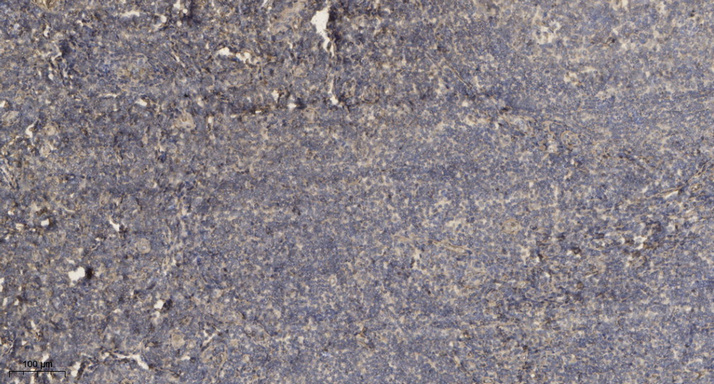ADAMTS-7 Polyclonal Antibody
- Catalog No.:YT0117
- Applications:IHC;IF;ELISA
- Reactivity:Human;Rat;Mouse;
- Target:
- ADAMTS-7
- Gene Name:
- ADAMTS7
- Protein Name:
- A disintegrin and metalloproteinase with thrombospondin motifs 7
- Human Gene Id:
- 11173
- Human Swiss Prot No:
- Q9UKP4
- Mouse Swiss Prot No:
- Q68SA9
- Immunogen:
- Synthesized peptide derived from ADAMTS-7 . at AA range: 150-230
- Specificity:
- ADAMTS-7 Polyclonal Antibody detects endogenous levels of ADAMTS-7 protein.
- Formulation:
- Liquid in PBS containing 50% glycerol, 0.5% BSA and 0.02% sodium azide.
- Source:
- Polyclonal, Rabbit,IgG
- Dilution:
- IHC 1:100 - 1:300. ELISA: 1:40000.. IF 1:50-200
- Purification:
- The antibody was affinity-purified from rabbit antiserum by affinity-chromatography using epitope-specific immunogen.
- Concentration:
- 1 mg/ml
- Storage Stability:
- -15°C to -25°C/1 year(Do not lower than -25°C)
- Other Name:
- ADAMTS7;A disintegrin and metalloproteinase with thrombospondin motifs 7;ADAM-TS 7;ADAM-TS7;ADAMTS-7;COMPase
- Molecular Weight(Da):
- 110kD
- Background:
- The protein encoded by this gene is a member of the ADAMTS (a disintegrin and metalloproteinase with thrombospondin motifs) family. Members of this family share several distinct protein modules, including a propeptide region, a metalloproteinase domain, a disintegrin-like domain, and a thrombospondin type 1 (TS) motif. Individual members of this family differ in the number of C-terminal TS motifs, and some have unique C-terminal domains. The encoded preproprotein is proteolytically processed to generate the mature enzyme. This enzyme contains two C-terminal TS motifs and may regulate vascular smooth muscle cell (VSMC) migration. Mutations in this gene may be associated with susceptibility to coronary artery disease. [provided by RefSeq, Feb 2016],
- Function:
- cofactor:Binds 1 zinc ion per subunit.,domain:The conserved cysteine present in the cysteine-switch motif binds the catalytic zinc ion, thus inhibiting the enzyme. The dissociation of the cysteine from the zinc ion upon the activation-peptide release activates the enzyme.,domain:The spacer domain and the TSP type-1 domains are important for a tight interaction with the extracellular matrix.,function:Metalloprotease that may play a role in the degradation of COMP.,induction:Up-regulated in articular cartilage and synovium from arthritis patients.,PTM:May be cleaved by a furin endopeptidase (By similarity). The precursor is sequentially processed.,PTM:N-glycosylated.,PTM:O-glycosylated proteoglycan. Contains chondroitin sulfate.,similarity:Contains 1 disintegrin domain.,similarity:Contains 1 peptidase M12B domain.,similarity:Contains 1 PLAC domain.,similarity:Contains 8 TSP type-1 domains.
- Subcellular Location:
- Secreted, extracellular space, extracellular matrix . Also found associated with the external cell surface. .
- Expression:
- Expressed in heart, brain, placenta, lung, liver, skeletal muscle, kidney and pancreas. Detected in meniscus, bone, tendon, cartilage, synovium, fat and ligaments.
ADAMTS-7 Expression Increases in the Early Stage of Angiotensin II-Induced Renal Injury in Elderly Mice. KIDNEY & BLOOD PRESSURE RESEARCH 2014 Mar 03 IHC Mouse kidneys
- June 19-2018
- WESTERN IMMUNOBLOTTING PROTOCOL
- June 19-2018
- IMMUNOHISTOCHEMISTRY-PARAFFIN PROTOCOL
- June 19-2018
- IMMUNOFLUORESCENCE PROTOCOL
- September 08-2020
- FLOW-CYTOMEYRT-PROTOCOL
- May 20-2022
- Cell-Based ELISA│解您多样本WB检测之困扰
- July 13-2018
- CELL-BASED-ELISA-PROTOCOL-FOR-ACETYL-PROTEIN
- July 13-2018
- CELL-BASED-ELISA-PROTOCOL-FOR-PHOSPHO-PROTEIN
- July 13-2018
- Antibody-FAQs
- Products Images

- Immunohistochemical analysis of paraffin-embedded human tonsil. 1, Antibody was diluted at 1:200(4° overnight). 2, Tris-EDTA,pH9.0 was used for antigen retrieval. 3,Secondary antibody was diluted at 1:200(room temperature, 30min).



